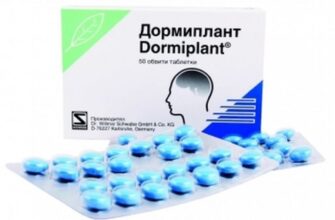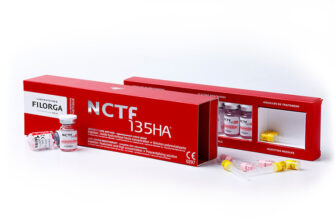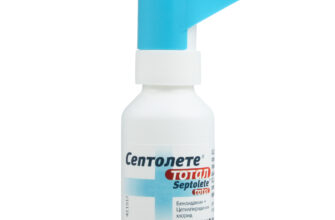Review of the best according to the editorial board. On the selection criteria. This material is subjective and does not constitute advertising and does not serve as a purchase guide. Before buying, you need to consult with a specialist.
At present, when there is a tendency in domestic medicine to reduce the cost of treatment, to replace imported drugs with domestic ones, it becomes necessary to explain the obvious facts. For example, how correctly a particular remedy is prescribed. A large number of 'pseudo-drugs' and nutritional supplements are emerging, which, in fact, are not drugs, are actively introduced into clinical practice.
At the same time, manufacturers actively and purposefully attack doctors, making them their adherents. We will not argue about the legality or illegality of this method of promotion, our goal is to enable a person who is not associated with medicine, at least in the first approximation, to understand how literate a doctor is and how right he is in his prescriptions. How can this be achieved? First of all, by comparing the prescribed medications with international and federal recommendations, with treatment protocols, according to a precisely set diagnosis. Today we have chosen mastopathy for a biased study.
We will adhere to the standard scheme. First, let's talk a little about the pathology itself, about its importance in medicine, and then we will move on to a description of those drugs that are used in international practice for treatment. The last section will describe the means by which mastopathy cannot be cured, and if they can be used, then only in complex therapy, or after real treatment, for example, with hormonal agents. Therefore, in the event that a patient has a confirmed diagnosis, but the doctor prescribes, for example, only homeopathic pills for her (and homeopathy is recognized as a pseudoscience all over the world), then it is better to look for another specialist. Let's decide, first of all, with the name, and with those specialists who should treat mastopathy.
- What is mastopathy and who treats it
- What is the connection between mastopathy and breast cancer?
- Why is there more cancer?
- Common risk factors for mastopathy and cancer
- Clinic of mastopathy
- How to treat mastopathy?
- Hormonal drugs for the treatment of mastopathy
- Means for the treatment of mastopathy
- Gestagens
- Duphaston (dihydrosterone)
- Advantages and disadvantages
- Utrozhestan (progesterone)
- Advantages and disadvantages
- Depo-Provera (Medroxyprogesterone)
- Advantages and disadvantages
- Progestogel
- Advantages and disadvantages
- Monophasic COCs: Yarina (Leia, Anabella, Midiana, Vidora, Delsia, Jess, Dimia) = drospirenone + ethinyl estradiol
- Yarina and analogues
- Advantages and disadvantages
- Gonadotropin antagonists, gonadotropin-releasing factor agonists
- Buserelin (nasal spray), Suprefact
- Advantages and disadvantages
- Toremifene (Fareston) – modern estrogen antagonist
- Non-hormonal drugs
What is mastopathy and who treats it
Mastopathy is a heterogeneous group of benign changes in the mammary glands that have certain clinical manifestations, and very often occurs in the reproductive, childbearing age. These changes can increase your risk of developing breast cancer. It should be especially emphasized that mastopathy itself, whatever it may be, is by no means a mandatory precancerous disease.
How common is mastopathy? In many countries, it occurs in half of all women, and the peak of detection of this pathology occurs between the ages of 30 and 45 years. Various synonyms can be found in the scientific literature: 'benign dysplasia of the mammary glands', 'fibroadenomatosis', 'fibrocystic dysplasia', and so on. Usually, four different types of diffuse mastopathy are distinguished, that is, without nodes, a mixed form, when, in addition to diffuse changes in the gland tissue, there are also nodes, as well as a nodular form. In addition, various benign nodes and other etiologies, such as lipomas, atheromas or vascular tumors, can form in the thickness of the mammary glands.
It is important to understand that the treatment of mastopathy has an extremely important function: it is the prevention of breast cancer.
The diagnosis of this pathology is not difficult, and the basis is an ultrasound scan, or an echographic examination of the mammary glands, mammography, and, if necessary, a histological examination of a biopsy of breast tissue. It is known that the use of instrumental research methods significantly increases the detection of pathology. If the diagnosis is made only on the basis of mammological examination, questioning and palpation of the mammary glands, then signs of mastopathy are found only in every 5 women. If ultrasound, mammography and histological studies are used, then the detection rate increases more than twice, and reaches 50%. Doctors-mammologists are professionally engaged in this pathology of the mammary gland, and this specialty is extremely closely related to gynecology and endocrinology. A mammologist does not have to be a surgeon. Most often, breast surgeons are oncologists. But dating them is usually not part of a woman's 'planned program'. Therefore, in order not to bring the matter to the oncological dispensary, each woman should independently and regularly conduct self-examination and palpation of the breast, and tell her gynecologist about the results in the antenatal clinic. And the next step will be to refer her to a mammologist, if you follow the state official scheme for attracting narrow specialists. What is the significance of this pathology, and how is mastopathy associated with malignant neoplasms of the breast?
What is the connection between mastopathy and breast cancer?
Mastopathy is a kind of beacon, or flashlight, which allows doctors to be especially wary of various forms of breast cancer. It is known that in our country any form of breast cancer occupies the first place in the structure of mortality among women from cancer. So, in 2017 alone, 75 thousand (!) Diagnoses were made for new cases of breast cancer. This is on a national scale – more than 5 cases per 10,000 women, or one new case per 2,000 women annually. Even more alarming is the fact that over the past 10 years this indicator has grown very strongly, by almost 23%, that is, the increase in the incidence of breast cancer is more than 2% per year. According to some reports, various forms of mastopathy are diagnosed in 60% of all women.
Why is there more cancer?
What are the alarming statistics related to? One of the reasons is the later onset of menopause, the small number of children born to women: the woman began to give birth infrequently. It is very important that women stopped breastfeeding for a long time, and stagnation of milk and lack of breastfeeding is a factor leading to the onset of mastopathy.
It turned out that the reproductive age of a woman has also increased, and the number of menstrual cycles over such a long period has also increased, and if earlier the number of cycles during the reproductive period of a woman in the XIX-XX centuries was about 200, now their number has doubled. This means that a modern civilized woman experiences a much longer period of the influence of estrogen on her body.
Common risk factors for mastopathy and cancer
The connection of various forms of mastopathy with the appearance of breast cancer has long been proven. Here are some of them. Breast disease and cancer have common risk factors, such as genetic, reproductive and hormonal:
- genetic includes the presence of blood relatives with cancer or mastopathy;
- reproductive risk factors for both mastopathy and oncological neoplasms include the early onset of menstruation and the absence of pregnancies, rare childbirth;
- hormonal risk factors in both cases are considered to be a high level of estrogen, a low concentration of progesterone in the second phase of the cycle, a high concentration of prolactin and especially a lack of thyroid hormones against this background.
Extragenital pathology is also of great importance. And in one, and in another case, the presence of diabetes mellitus, obesity (especially after the onset of menopause), the presence of metabolic syndrome contributes to the appearance of both malignant neoplasms and various forms of mastopathy.
To this can be added the factors of influence of the external environment. Both mastopathy and cancer are caused by 'standard', urban eating disorders. These include the usual skewed diet. It:
- large amounts of refined fat, canned food, fast carbohydrates, fast food;
- the appearance of technical palm oil, a carcinogenic oil in cheap milk and cheeses, as 'substitutes' for milk fat;
- excess calorie content and high concentration of animal proteins;
- a small amount of fiber, vegetables and fruits.
Smoking, lack of sleep, physical inactivity and chronic stress lead to the development of both mastopathy and cancer. If we add to this that the development of cancer cells and mastopathy have common features, for example, excessive proliferation of the epithelium of the lobules and ducts, then everything will become clear. The various forms of mastopathy and cancer are very closely related. This is all the more proven that when the mammary gland is removed due to cancer, signs of mastopathy are often found in the tissues surrounding the tumor, which are confirmed histologically.
It was revealed that proliferative, that is, growing forms of mastopathy lead to the appearance of a large number of estrogen receptors in the tissues, the processes of programmed cell death, or apoptosis, are disrupted, vascularization of the mammary gland tissue is increased, that is, an excessive number of vessels appears, leading to excessive growth of the epithelium. And this is an excellent “springboard” for the growth of cancer cells, because cancerous tumors behave in the same way. As a result, it can be considered that in itself, (although mastopathy is not a cancer), it may well be considered an independent and serious risk factor.
Looking ahead, let's say that one of the signs of mastopathy, for example, mastodynia or mastalgia (this is prolonged pain in the mammary gland associated with a cycle), increases the risk of developing cancer by almost 5 and a half times. Is there any temporary backlog during which a woman can seriously take care of her health? Is it possible that after mastopathy, cancer occurs 'immediately'? Yes, there is such a range. Usually, the average age of detection of mastopathy, and confirmation of the diagnosis using histological examination, that is, the most reliable diagnostic method, is about 46 years. At the same time, the average age of a woman who is diagnosed with any malignant neoplasm of the mammary glands, on average, in the Russian population is 56 years.
As a result, we can conclude that from the diagnosis of mastopathy to the appearance of cancer (if it appears), on average, it takes 10 years. And during this time, you can do a lot. However, this should not be misinterpreted. Breast cancer does not necessarily develop 10 years after the diagnosis of mastopathy. It may never appear at all. But still, statistics show that a woman with mastopathy has a higher risk of cancer.
It is also very important to remember that just a diagnosis of mastopathy also does not give the right to automatically tell a woman that her risk of breast cancer has increased dramatically. It causes fear, stress, depression. And depression is also a risk factor for cancer. In order to draw this conclusion, it is not only necessary for a doctor to have a diagnosis of mastopathy in his hands, but it is worth carefully assessing all the factors affecting a woman, which were mentioned above, from hormonal to hereditary. How does mastopathy manifest?
Clinic of mastopathy
What are the main signs of mastopathy? How does this functional and then organic hormonal disorder manifest? First of all, these are symptoms such as:
- pain that occurs in one or both breasts. The pain can be very different, it can be given to the scapula, armpit or shoulder. A very characteristic symptom is the disappearance of pain syndrome with the first day of menstruation, or approximately at this time, with the onset of the menstrual cycle;
- a combination of soreness of the mammary glands and a feeling of their bursting, enlargement of the mammary gland, its edema. Some women figuratively say that the breasts are like 'pumped up'. However, in some women, pain syndrome may be completely absent, or it is, but does not depend on the phase of the menstrual cycle;
- discharge from the nipples, it is either a transparent liquid that is released dropwise, or whitish, similar to colostrum;
- a combination of chest pain and other symptoms of premenstrual syndrome. This is a one-sided throbbing headache that resembles a migraine, swelling, nausea, and sometimes vomiting are possible;
- depression, tearfulness and irritability appear.
Such anxiety is often combined with carcinophobia, especially if the doctor did not explain to the patient all the features of this disease, but at the same time frightened the patient with the possibility of contracting cancer.
Why does this clinical picture arise? It was said above that the mammary glands are organs that respond very well to changes in hormonal levels, and this is true. Usually estrogens, or hormones secreted by the ovaries, stimulate breast enlargement, and this usually occurs on day 8 of the cycle. The increase is due to the fact that hormones bind to specific estrogen receptors, and the proliferation of galactogenic cells located in the mammary gland and producing milk is stimulated.
In addition, estrogens affect the epithelium as growth factors and weaken the influence of inhibitory factors. The clinical picture of pain, edema and swelling of the mammary glands depends on the combined action.
After ovulation, in the second phase of the cycle, the hormones change 'places', and the mammary glands are no longer affected by estrogens, but by progesterone. But this does not mean that all symptoms disappear immediately, not at all. Progesterone is able to retain extracellular fluid, and this leads to the fact that the breast is further enlarged and denser.
But if a woman is not pregnant, if she does not have a corpus luteum of pregnancy, and progesterone stops acting, then the duration of its effect on the mammary glands does not exceed 2 weeks. As soon as its effect ends, and estrogens have not yet appeared in the blood in high amounts, that is, by the beginning of menstruation, then all symptoms decrease, or completely disappear.
How to treat mastopathy?
If we consider the clinical picture, then it is clear that such complex and complex endocrine changes in the body should be treated taking into account the existing symptoms. Therefore, a variety of agents are used, ranging from tonic, adaptogens, and ending with antidepressants, and biogenic stimulants.
But still, real, specific treatment of clinically pronounced mastopathy, which reduces the quality of life, is necessarily carried out taking into account the recommendations of a gynecologist-endocrinologist, and is associated with the use of various hormonal drugs. These are gestagenic agents, antagonists of gonadotropic hormones of the pituitary gland, agonists of gonadotropin-releasing factors, monophasic combined oral contraceptives (COCs), which are widely used in the clinical practice of gynecologists-endocrinologists and mammologists who treat mastopathy.
There is another 'pole' when patients, despite the presence of indications, are not treated with hormones. This is possible if the symptoms of mastopathy are not pronounced, and its histological characteristics do not cause any concern, and the degree of proliferation of glandular tissue and the risk of nodule formation is small. In this case, indeed, you can use a variety of non-hormonal drugs, which include nutritional supplements.
Consider these two large groups of drugs – hormonal and non-hormonal drugs that are used to treat different types of mastopathy. For drugs, an international non-proprietary name (INN) will be given, then the name of the most famous, or original drug, which began to be produced in the first place. Then, if any, commercial counterparts, or generics, will be considered. A price range will also be given that is relevant for all pharmacies in the Russian Federation for the end of 2019. The listed drugs are not rated, they are not assigned a place, and the sequence of their inclusion in the text is explained either by random sampling, or alphabetical order, or by belonging to a particular class, according to the anatomical and therapeutic classification. The author does not intend to promote any product, or especially to criticize any drugs for the sake of certain manufacturers.
Hormonal drugs for the treatment of mastopathy
Since the functional state of breast tissues depends on hormones, their role in the formation of mastopathy is greatest. The greatest importance in the appearance of a dyshormonal state, as mentioned above, is assigned to the abnormal ratio between estrogen and progesterone, which is reduced to a deficiency of progesterone.
It is known that estradiol is the most important estrogen affecting the mammary gland. This is proved at least by the fact that its concentration in the tissues of the mammary gland can be 20 times higher than its maximum permissible concentration in the blood serum. As mentioned above, it stimulates all processes of differentiation and development in the mammary gland, enhances cell division, and increases the volume of connective tissue.
Progesterone has the opposite effect. It inhibits cell proliferation, and its concentration in breast tissue can be 10 times higher than in blood. It is the deficiency of progesterone that is accompanied by edema and hypertrophy of the connective tissue, which is the stroma for the epithelial lobules. Therefore, hormones belonging to gestagens and anti-estrogen drugs have found the greatest application in the treatment of mastopathy. The use of gonadotropin agonists and some types of oral contraceptives (COCs) also plays an important role. Let us first consider progestational agents, since it is with them that the treatment of mastopathy most often begins.
Means for the treatment of mastopathy
| Nomination | a place | Name of product | price |
| Gestagens | 1 | Duphaston (dihydrosterone) | 576 r |
| 2 | Utrozhestan (progesterone) | 395 RUB | |
| 3 | Depo-Provera (Medroxyprogesterone) | 108 RUB | |
| 4 | Progestogel | 935 RUB | |
| Monophasic COCs: Yarina (Leia, Anabella, Midiana, Vidora, Delsia, Jess, Dimia) = drospirenone + ethinyl estradiol | 1 | Yarina and analogues | RUB 1,110 |
| Gonadotropin antagonists, gonadotropin-releasing factor agonists | 1 | Buserelin (nasal spray), Suprefact | 626 RUB |
| 2 | Toremifene (Fareston) – modern estrogen antagonist | RUB 2,282 |
Gestagens
Progestational drugs inhibit the connection between the pituitary gland and the ovaries, and reduce the stimulating effect of estrogen on the mammary glands. In the treatment of mastopathy, either natural or, most often, synthetic drugs are used. In the latter case, it is levonorgestrel and its analogues. Progestational agents should be prescribed taking into account the concomitant symptoms, especially when it comes to the combination of mastopathy with uterine myoma, endometrial hyperplasia or endometriosis.
Drugs from this group are used in the second phase of the cycle, and may or may not have androgen-like side effects. Some drugs can be used intravaginally, for example Utrozhestan. This is important in the presence of concomitant liver pathology. Also, in the treatment of mastopathy, prolonged progestogens are also used, for example, Depo-Provera. They do not affect normal tissue in the mammary glands, but inhibit active proliferation. All gestagens should not be used in women with severe liver dysfunction, in the presence of thrombophlebitis, or cardiovascular failure. Currently, their local application is also possible (Progestogel).
Duphaston (dihydrosterone)
Popularity rating: 4.9
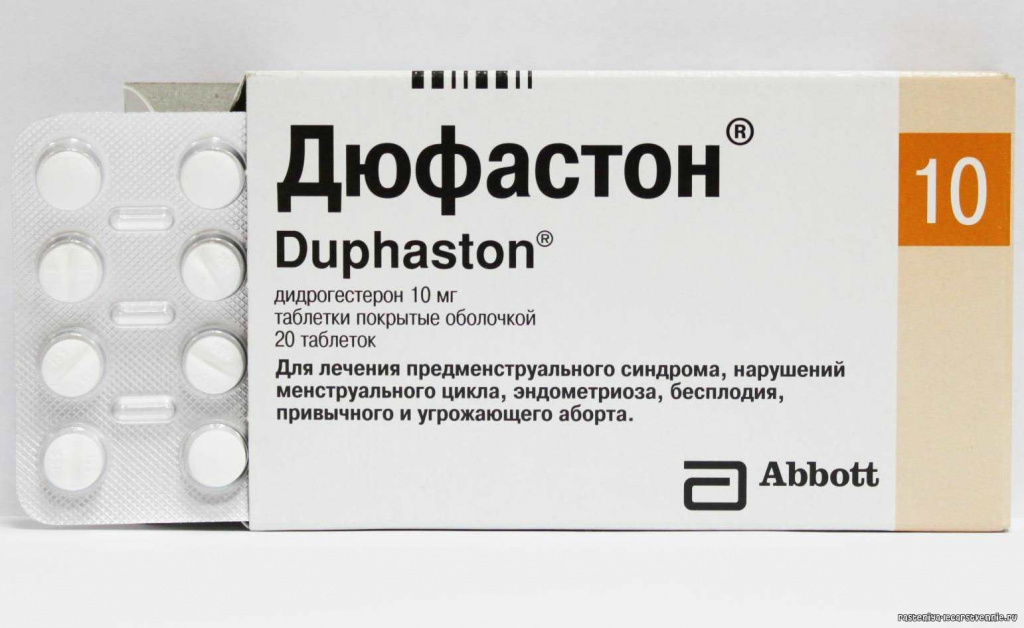
Duphaston is a 'standard' progestogen that is indicated for all possible cases of progesterone deficiency. It not only acts in the endometrium, reducing the risk of its hyperplasia, but also works inside the breast tissue, depressing the proliferation and, accordingly, estrogen-related carcinogenesis.
It is interesting that in the official indications for the use of Duphaston there is no such diagnosis as mastopathy. It is used for threatening and habitual miscarriage, for secondary amenorrhea, for dysfunctional uterine bleeding, as well as for supporting the luteal phase, and for endometriosis. But on the other hand, in the official instructions there is such a general indication as 'a condition characterized by a deficiency of progesterone'. It is here that various types of mastopathy are included.
Dufaston is used orally, in the second half of the cycle, at the usual dosage of 10 mg 2 times a day, but the attending physician gives a detailed indication of the dosage. Duphaston is produced by Abbott, and a pack of 28 tablets of 10 mg, calculated on average for 1 month or two weeks of administration, will cost from 650 to 750 rubles.
Advantages and disadvantages
It is important that Duphaston does not have a contraceptive effect, and dihydrotestosterone does not suppress ovulation. A big advantage is the fact that Duphaston does not have androgenic, anabolic activity, does not have the properties of glucocorticosteroids and also latent estrogenic activity.
It is contraindicated in the presence of oncological processes that are sensitive to progesterone, in the presence of severe liver dysfunction and vaginal bleeding, during breastfeeding, as well as in severe thrombotic conditions, with deep vein thrombosis, myocardial infarction and pre-infarction conditions, cerebrovascular pathology, and many others diseases. Duphaston can have side effects such as depression, migraine-like angiocephalgia, nausea, and some menstrual irregularities.
Utrozhestan (progesterone)
Popularity rating: 4.8
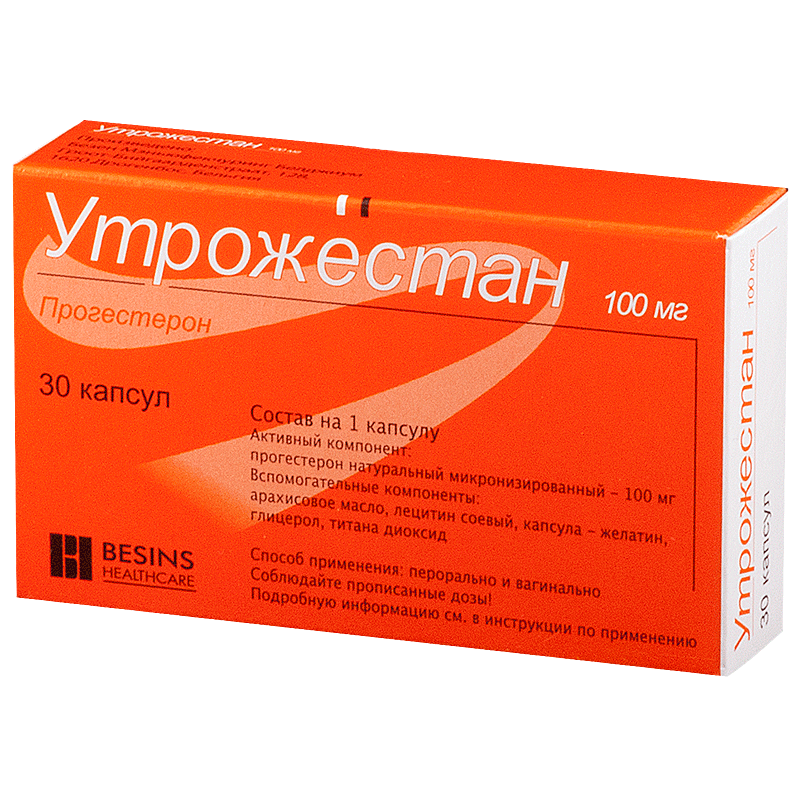
Utrozhestan is a pure progesterone, which is used, like other gestagens, for diseases such as ovarian dysfunction, dysmenorrhea, premenstrual syndrome, recurrent miscarriage and infertility, premature birth, menopause, and even in vitro fertilization. However, Utrozhestan already has such an official indication for use as diffuse cystic mastopathy.
The drug can be used, including intravaginal capsules, which are prescribed to patients with liver function disorders, and in this case the active substance does not pass through the portal system and does not affect the oven. In all other cases, the drug is taken orally, and taking the drug is usually necessary for mastopathy in a daily dose of 200 or 400 mg, it must be taken within 10 days, and usually this is from 16-18 to 25 or 26 days of the cycle.
Utrozhestan is produced by the Thai company Olik, and one pack of 28 capsules of 100 mg each, designed for one week of admission at a maximum dosage of 400 mg, will retail from 360 to 400 rubles.
Advantages and disadvantages
The advantage of Utrozhestan is the possibility of intravaginal administration, but it is necessary to take into account the standard contraindications for taking gestagens. These are deep thrombosis, vaginal bleeding, or suspected malignant neoplasm, including breast or genital cancer. The drug should not be used in girls under 18 years of age, and there are a number of restrictions, for example, bronchial asthma and arterial hypertension.
Utrozhestan can have side effects, and most often it is a menstrual disorder, headache, and bloating. Overdose effects may also be present, such as drowsiness, dizziness or euphoria. It is very important to add that Utrozhestan cannot be used with food, and patients with cardiovascular diseases should be additionally monitored by a cardiologist during treatment, as well as patients with thrombophlebitis.
Depo-Provera (Medroxyprogesterone)
Popularity rating: 4.7

This drug is a synthetic medroxyprogesterone drug that is intended for intramuscular administration. This remedy was originally intended as an anticancer drug, but it can also be used to treat severe forms of mastopathy, affecting the hypothalamic-pituitary-ovarian system, as well as estrogen receptors. One should not be afraid that the indications for the use of the drug include only oncological pathology: metastatic endometrial cancer, breast cancer or kidney cancer. No one will prescribe this serious drug to a patient with a mild form of mastopathy, there should be extremely strict indications. Usually, for malignant neoplasms of the mammary gland, the agent is prescribed intramuscularly daily for a month, and the mammologist will determine the dosage in the presence of mastopathy. The Pfizer company produces this product, and one injection will cost from 90 to 125 rubles.
Advantages and disadvantages
The disadvantage of this remedy is a powerful systemic effect, the ability to develop thromboembolic complications, depression and various uterine bleeding, amenorrhea and decreased libido. It is strictly forbidden to use Depo-Provera in the form of self-medication, indications must be carefully determined, as well as concomitant pathology. The medicine increases the risk of thromboembolism, fluid retention, osteoporosis, and increases body weight. Unlike the above drugs, Depo-Provera can produce glucocorticosteroid effects, for example, the same osteoporosis or impaired glucose tolerance. Therefore, it cannot be pricked for a long time, and necessarily – under the control of analyzes.
Progestogel
Popularity rating: 4.7
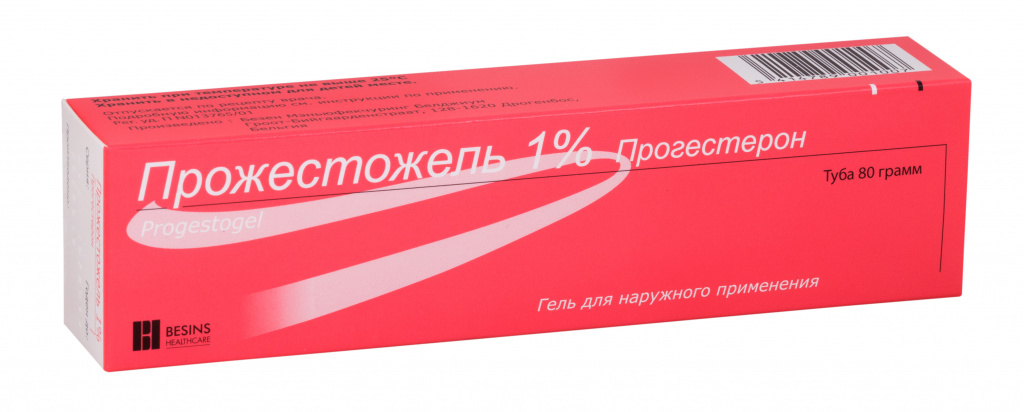
This Belgian drug is a topical progestogen, which is very rare, and has existed in Russia since 1999. Progestogel is a progesterone that is applied as a cutaneous application to the mammary gland as a gel. Its external use allows increasing the concentration of progesterone inside the breast tissue, and thereby eliminates the imbalance between estrogens and progestins. This drug affects, directly inactivating Estradiol, acts on the epithelium and vessels of the mammary gland, and reduces capillary permeability. As a result, it reduces edema and relieves pain. Progestogel is very well tolerated and is applied with the applicator to the skin of each breast, except for the nipple and areola. It should be applied 2.5 g of gel on each gland once a day, and the duration of the course should be several months, up to six.
Within an hour after the application of Progestogel, it is maximally absorbed into the tissue. The main indications for use are mastodynia and diffuse fibrocystic mastopathy. It is necessary to start treatment in the second phase of the cycle, from 16 to 25 days, and only if the desired is not achieved, then it will be necessary to switch to the daily application regimen. The product is produced by the Belgian company Bezen, and 1 tube of 80 g of transparent, alcoholic gel will cost from 830 to 550 rubles.
Advantages and disadvantages
The most serious advantage of Progestogel can be considered its local administration, and therefore, no more than 10% of the total applied drug is absorbed into the systemic circulation, even with daily use, systemic absorption is very low. The medicine can be prescribed not only for mastodynia, or pain in the mammary gland associated with mastopathy. It can be used if there are side effects from oral contraceptives. It is in demand in puberty, in the presence of premenstrual syndrome.
There are also contraindications. This is the presence of not diffuse, but a nodular form of mastopathy. Therefore, simply in the presence of an unspecified or presumptive diagnosis of 'mastopathy', this wonderful remedy cannot be used; it is necessary to obtain confirmation of the diffuse nature of the process by conducting an ultrasound or mammography. Progestogel is also contraindicated in the second and third trimester of pregnancy, with breast and endometrial cancer.
Monophasic COCs: Yarina (Leia, Anabella, Midiana, Vidora, Delsia, Jess, Dimia) = drospirenone + ethinyl estradiol
Yarina and analogues
Popularity rating: 4.9
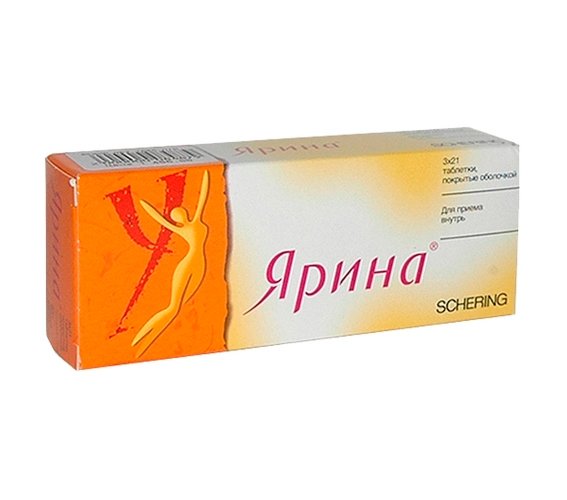
The list of oral COCs is opened by monophasic drugs. They are used to treat various forms of mastopathy. The big advantage of these drugs, for example Yarina, is the ability to take any pill on any day of the cycle, since the amount of active ingredient in them is exactly the same. But for two- and three-phase drugs, there is always a dosage regimen. It is forbidden to take them “anyhow”, it can cause serious consequences. The cycle can be so upset that you have to perform a temporary complete stop – medical castration, so that it recovers. In some cases, the tablets have different colors, they are assigned numbers, and so on. For Yarina, Jess, other monophasic COCs and their analogs, this need not be done.
Yarina and analogues are low-dose monophasic oral contraceptives. How do they work? By increasing the viscosity of the cervical mucus, in which the sperm eventually become entangled. But even if they make their way through the barrier, then they will not find an egg ready for fertilization, because ovulation has not occurred. However, certain rules of admission are required, although they are the simplest of all groups of oral contraceptives. But the disappearance of the symptoms of mastopathy and the improvement in the condition of the mammary glands is associated with the correct, 'imposed' hormonal rhythm.
The tool is applied for 21 days (one cycle of administration) and at the same time of the day. If a woman decides to start using COCs of this group, then she cannot start taking it on any day, and preferably only on the first day when menstruation began, that is, the first day of the cycle.
Since the package contains exactly 21 tablets, after the package is finished, a break is taken for 7 days. During this time, the woman will have bleeding that resembles menstruation, and doctors call this 'withdrawal bleeding'. This phenomenon develops literally 2-3 days after the woman took the last, 21st pill. When these seven days pass, you can purchase a new package and continue taking it again.
What if a woman did not have time to start taking Yarina with the first day of her period? She, of course, can manage to start on the second day, on the third, and even on the fifth, but then during these days it is necessary to use other contraceptives. But what if you missed the pill for forgetfulness? If less than half a day has passed, then you can simply make up for the dosage, nothing bad will happen. The next tablet is taken as usual. But if the reception is missed for a day, then the effect will be lower.
A typical representative of this group will be Yarina's drug (Schering-Plow, Germany). One package costs about 1000 rubles. If we take analogs, then the Hungarian Midiana from Gedeon Richter costs 650 rubles, with the European quality of the substance.
Advantages and disadvantages
The advantage of funds from this group is not only the effect and the relative ease of administration. Yarina and other monophasic COCs have a pronounced antiandrogenic effect. They also work against the concentration of male hormones. Therefore, these COCs are used according to indications in the treatment of severe acne, since the production of sebum decreases, and its intensity is precisely regulated by male sex hormones – androgens. But it should be remembered that if a woman has vascular thrombosis, diabetes with neuropathy or kidney damage, if a woman is breastfeeding, then this drug and other monophasic contraceptives (and all other COCs) are contraindicated for her. Although breastfeeding is a natural way to prevent mastopathy, and if it is possible to maintain natural feeding, then you need to be patient. Nature disposes wisely.
Gonadotropin antagonists, gonadotropin-releasing factor agonists
In addition to the drugs described above, the so-called 'heavy artillery' is also used to treat some forms of mastopathy, which already works not even at the level of pituitary hormones, but even higher. For example, gonadotropin-releasing factors are those substances that are produced in microdoses by the higher division of the autonomic nervous system – the hypothalamus. Naturally, these funds can be used only very rarely, and only under the supervision of a mammologist, and a gynecologist-endocrinologist, or an oncologist – mammologist. Let's describe some of them.
Buserelin (nasal spray), Suprefact
Popularity rating: 4.9
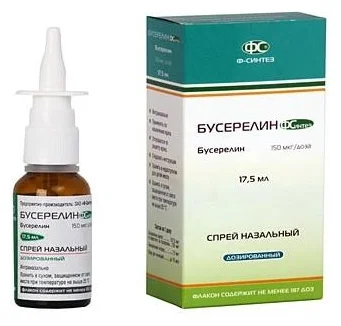
Buserelin is a widely known 'in narrow circles' drug, which belongs to synthetic analogs of gonadotropin-releasing factors. This allows it to have antitumor, antiandrogenic and antiestrogenic effects. It generally suppresses all the effects of gonadotropic hormones indiscriminately, regardless of whether they are male or female. Its use has its own subtleties. At the very beginning of the introduction, it stimulates the release of gonadotropic hormones, that is, follicle-stimulating and luteinizing, but constant use blocks this function of the release of sex hormones by the pituitary gland, which occurs after about 2 weeks.
As a result, the synthesis of sex hormones in the ovaries decreases, and their level drops to approximately menopausal values. If Buserelin is canceled, then the hormones gradually return to normal. This allows it to be used in various forms of endometriosis, for the treatment of prostate cancer, and breast cancer in women. Moreover, the latter indication requires the presence of receptors for estradiol and progesterone on the tumor. And we know that it is the excess of estrogen receptors that forms the clinical picture of mastopathy. Buserelin is administered in the form of an intranasal spray, as well as in the form of intramuscular and subcutaneous injections according to special schemes. Buserelin is produced by a domestic company and a spray containing several doses can be purchased at a price of 600 to 820 rubles.
Advantages and disadvantages
The advantage of this drug is its good, long-lasting effect. But in order to use it, a combination of special indications is required, for example, a high risk of developing breast cancer, or the confidence that the patient is balancing between mastopathy and the initial manifestations of the tumor against the background of a large number of risk factors.
Before starting treatment, it is imperative to exclude pregnancy, the drug should be used especially carefully in patients with depression, and Buserelin should not be used with other drugs that contain sex hormones. Various side effects are possible such as headache, appetite changes. But the main thing is the symptoms of medical castration. Libido goes down to almost zero, vaginal dryness occurs, and possibly other symptoms.
Toremifene (Fareston) – modern estrogen antagonist
Popularity rating: 4.8
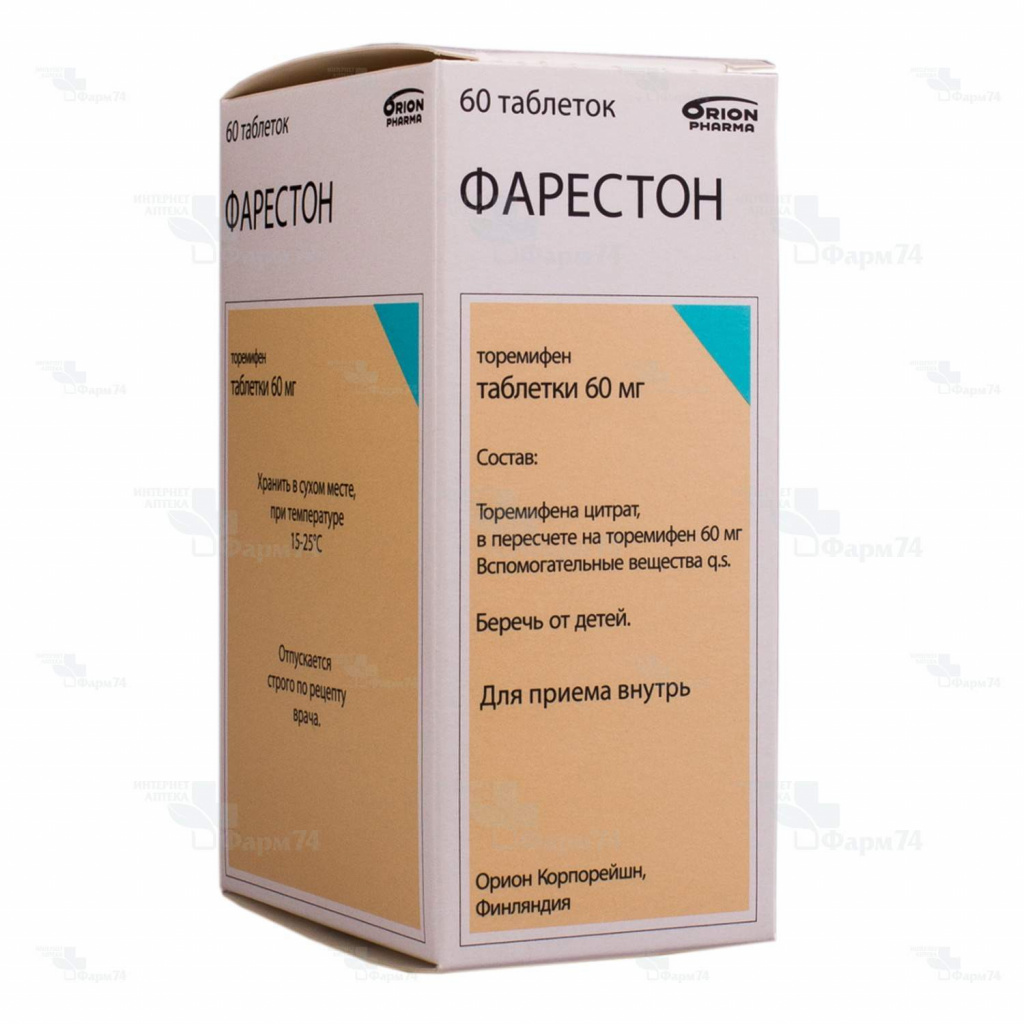
Toremifene is also an antineoplastic agent, which belongs to antiestrogenic drugs. But, unlike Buserelin, it does not affect the functioning of the brain, but acts directly in the tissues of tumor cells, as well as other structures, blocking estrogen receptors. Toremifene is a modern and rather expensive product. The drug is produced by the Finnish company Orion, and one pack of 30 tablets, 20 mg each, can be found on sale at a price of 1600 to 2700 rubles.
But an older and well-known drug from the same group, tamoxifen, is sold much cheaper: at prices ranging from 110 to 130 rubles, this is a domestic product. At the same time, Tamoxifen is also an estrogen receptor blocker, and the strength of action of both Toremifen and Tamoxifen is approximately the same. So why is Toremifen at least 14 times more expensive than Tamoxifen? But let's say it is produced by an import company from Finland, and Tamoxifen is produced by a domestic company. But the price gap is very high. Why?
This is due to the fact that Toremifen is a safer city, it has a milder and more favorable spectrum of side effects. Thus, the classic thromboembolic complications that are characteristic of these drugs often force women to stop therapy with Tamoxifen due to the development of thrombosis or embolism. Toremifene acts milder, and there is no need to stop therapy, therefore, in addition to mild side effects, it has the highest safety with the same effectiveness, which has been proven by modern randomized trials. Its use in higher doses is safer and the time to full effect is shorter than that of Tamoxifen. This is very important if you want to get the effect faster.
This drug has one official indication, such as estrogen-dependent breast cancer during menopause. But many experts believe that its use in mastopathy for appropriate indications and under the necessary conditions is also possible, and there is relevant clinical experience, and publications in medical journals. We will not give dosage regimes here, so as not to tempt patients to self-medicate, only a doctor prescribes medicine. Therefore, we will not separately talk about the advantages and disadvantages, they are quite clear from a brief description.
Non-hormonal drugs
Now we know the most serious drugs that help well against mastopathy and affect hormonal metabolism. But almost always there are a lot of non-hormonal drugs in pharmacies. These medicines are sold without a prescription. Unfortunately, they also include homeopathic medicines that do not help at all, which are still sometimes advertised even by doctors, although homeopathic medicines lack even the very principle of action. As you know, the commission of the Russian Academy of Sciences recognized homeopathy as a pseudoscience, and individual attempts to revive it at the highest level only prove the catastrophic lag of domestic medicine from the global level.
Many herbal remedies that are advertised as 'only natural herbal ingredients' are considered non-hormonal drugs for mastopathy. They can contain iodine, kelp extract, fatty acids, chlorophyll derivatives, bee products, proteolytic enzymes – anything you want, even mumiyo.
However, smart manufacturers will not recommend all of these products that are nutritional supplements for monotherapy. The instructions for use will definitely recommend 'use it only in complex therapy', that is, together with other, 'real' drugs. Those who know how to read even official documents 'between the lines' are well aware that this phrase means only one thing: individually, taken by itself, the 'drug from natural ingredients' signifies its own impotence.
Therefore, in order to avoid unjustified expenditures of money, in the presence of symptoms of mastopathy, or risk factors, you need not listen to pharmacists who have a specific plan for selling over-the-counter domestic products, but go to a mammologist, gynecologist-endocrinologist, perform mammography and ultrasound of the mammary glands, and the specialists will decide what drugs you need.
The popularity rating is based on the analysis of demand data from the wordstat.yandex.ru service.
Attention! This rating is subjective and does not constitute an advertisement and does not serve as a purchase guide. Before buying, you need to consult with a specialist.



